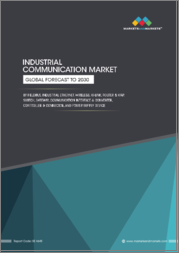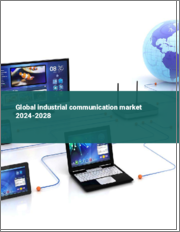
|
시장보고서
상품코드
1351033
세계의 차세대 통신 기기 시장(2023-2030년)Global Next-generation Communication Devices Market 2023-2030 |
||||||
세계 차세대 통신 기기 시장은 예측 기간 동안 연평균 20.0%의 높은 성장률을 나타낼 것으로 예상됩니다. 시장 성장 요인으로는 5G 기술 보급, 가시광통신/Li-Fi 수요 증가, 다양한 산업에서 무선 센서 네트워크(WSN)의 보급 확대, 기타 혁신적인 통신 기술의 지속적인 개발 등이 꼽힙니다. 첨단 통신 기술을 장려하는 정부의 지원 정책이 시장을 촉진할 것으로 예상됩니다. 예를 들어, 2021년 4월 미국 국립과학재단(NSF)은 국방부 연구공학부 차관실, 국립표준기술연구소, 9개 대기업과 공동으로 차세대 네트워킹 및 컴퓨팅 시스템 연구를 가속화하는 프로그램을 시작했습니다. 000만 달러의 투자를 통해 휴대폰, 와이파이, 위성 네트워크의 미래 버전에 대한 연구를 지원합니다. 이는 더 빠른 서비스, 자연재해 및 서비스 중단에 강한 네트워크, 세계 사람들이 광범위하게 접속할 수 있는 차세대 무선 연결의 토대를 마련할 것입니다.
부문별 전망
5G 기술 부문이 차세대 통신장비 세계 시장에서 큰 성장세를 보일 것으로 전망
이 중 5G 기술 부문은 세계적으로 5G 네트워크의 채택이 증가하고 있고, 다양한 산업 분야에서 변화의 잠재력이 있기 때문에 큰 성장이 예상되고 있습니다.
이러한 5G 성장 전망은 5G가 제공하는 향상된 연결성, 데이터 수요 증가, IoT 및 스마트 기기의 확산, 다양한 비즈니스 용도의 채택, 5G 네트워크 인프라의 발전, 최신 기술에 대한 소비자의 기대, 기기 제조업체 간경쟁 구도 등 여러 요인에 의해 이루어졌습니다.
지역별 전망
세계 차세대 통신 기기 시장은 북미(미국, 캐나다), 유럽(이탈리아, 스페인, 독일, 프랑스, 기타), 아시아태평양(인도, 중국, 일본, 한국, 기타), 기타 지역(중동 및 아프리카, 라틴아메리카) 등 지역별로 세분화되어 있습니다. 이들 지역 중 유럽은 통신 기술 발전, 정부의 강력한 지원, 다양한 산업 분야 수요 증가로 인해 차세대 통신 기기 시장의 괄목할 만한 성장이 예상됩니다. 차세대 통신 기술을 촉진하기 위해 민간 기업과 정부 기관 모두에서 자금 지원과 투자를 늘리고 있는 것이 시장을 주도하고 있습니다. 예를 들어, 2021년 4월 독일 연방교육연구부(Bundesministerium fur Bildung und Forschung, BMBF)는 5G를 중심으로 한 미래 통신 기술을 위한 혁신 생태계의 기반을 구축하는 것을 목표로 2022년에서 2027년 사이에 5G 연구개발을 위해 5억 달러를 배정했습니다.
아태지역, 차세대 통신장비 시장에서 괄목할 만한 성장 전망
아시아태평양은 5G 인프라의 급속한 확장, 스마트폰 보급률 증가, 인도, 중국, 한국 등의 국가에서 스마트 교통 및 자동차 솔루션에 대한 수요 증가로 인해 차세대 통신 기기 시장에서 상당한 성장이 예상되고 있습니다. 예를 들어, 2019년 2월 International Data Corp.(IDC)가 발표한 보고서에 따르면, 중국 정부가 주도하는 중국의 스마트시티 투자는 2022년까지 298억 달러에 달할 것으로 예상됩니다. 이 투자는 디지털 신뢰성, 복원력, 악천후, 사이버 공격, 팬데믹 회복과 같은 현재 추세에 적응하는 데 초점을 맞추고 있습니다. 목표는 전략적 기술 투자 로드맵과 관련 정책 및 문화 변화를 통해 스마트 시티와 커뮤니티의 도시 디지털 전환을 지속하는 것입니다.
목차
제1장 보고서 개요
- 업계 현황 분석과 성장 가능성 전망
- 조사 방법과 툴
- 시장 내역
- 부문별
- 지역별
제2장 시장 개요와 인사이트
- 조사 범위
- 애널리스트 인사이트와 현재 시장 동향
- 주요 조사 결과
- 추천 사항
- 결론
제3장 경쟁 구도
- 주요 기업 분석
- Cisco Systems Inc.
- 개요
- 재무 분석
- SWOT 분석
- 최근 동향
- Ericsson AB
- 기업 개요
- 재무 분석
- SWOT 분석
- 최근 동향
- Huawei Device Co., Ltd.
- 개요
- 재무 분석
- SWOT 분석
- 최근 동향
- Netgear Inc.
- 개요
- 재무 분석
- SWOT 분석
- 최근 동향
- Philips
- 개요
- 재무 분석
- SWOT 분석
- 최근 동향
- 주요 전략 분석
제4장 시장 세분화
- 세계의 차세대 통신 기기 시장 : 기술별
- 5G
- 가시광 통신/Li-Fi
- 무선 센서 네트워크(WSN)
- 기타 기술(위성통신, 밀리미터파 기술)
- 세계의 차세대 통신 기기 시장 : 최종사용자 산업별
- 제조업
- 군 및 방위
- 자동차
- 운송
- 기타 최종사용자 산업(헬스케어, 관개)
제5장 지역 분석
- 북미
- 미국
- 캐나다
- 유럽
- 영국
- 독일
- 이탈리아
- 스페인
- 프랑스
- 기타 유럽
- 아시아태평양
- 중국
- 인도
- 일본
- 한국
- 기타 아시아태평양
- 세계 기타 지역
제6장 기업 개요
- AT&T
- Devicescape Software, Inc.
- Diebold Nixdorf, Inc.
- General Cable Corporation
- Hitachi Cable America, Inc.
- OFS Fitel LLC
- Plantronics, Inc.
- Purple Wi-Fi Holdings Ltd.
- Quantum Corp.
- Silicon Laboratories, Inc.
- Toshiba Corp.
- Verizon Communications, Inc.
- Vodafone Group Plc
- Vizio Inc.
- Yahoo
Title: Global Next-generation Communication Devices Market Size, Share & Trends Analysis Report by Technology (5G, Visible Light Communication/ Li-Fi, Wireless Sensor Networks (WSN), and Others) and by End-User Industry (Manufacturing, Military & Defense, Automotive, Transportation, and Others)Forecast Period (2023-2030).
The global next-generation communication devices market is anticipated to grow at a considerable CAGR of 20.0% during the forecast period. The market growth is attributed to factors such as the widespread adoption of 5G technologies, the increasing demand for Visible Light Communication/ Li-Fi, the growing deployment of Wireless Sensor Networks (WSN) in various industries, and the continuous development of other innovative communication technologies. A supportive government policy to boost advance communication technologies is anticipated to propel the market. For instance, in April 2021, The National Science Foundation (NSF) of the US, in partnership with the Department of Defense Office of the Undersecretary of Defense for Research and Engineering, the National Institute of Standards and Technology, and nine leading companies, launched a program to accelerate research on next-generation networking and computing systems. Through a $40 million investment, the NSF-led RINGS program support research on future versions of the cellular, Wi-Fi, and satellite networks. It lay the groundwork for the next-generation wireless connections that enable faster service, networks more resilient to natural disasters and service interruptions, and broader access for people around the globe.
Segmental Outlook
The global next-generation communication devices market is segmented based on its technology and end-user industry. By technology, the market is categorized into 5G, Visible Light Communication/ Li-Fi, Wireless Sensor Networks (WSN), and Other Technologies. On the other hand, the market is segmented by end-user industry, including Manufacturing, Military & Defense, Automotive, Transportation, and Other End-user Industries. Among the technology segments, the Visible Light Communication / Li-Fi sub-segment is anticipated to register significant growth during the forecast period. The growth of this segment is attributed to factors such as the increasing demand for high-speed and secure data transmission, especially in indoor environments where traditional radio frequencies may face limitations.
5G Technology Segment Is Expected To Witness Significant Growth in Global Next-generation Communication Devices Market
Among these segments, the 5G technology segment is expected to witness significant growth due to the increasing adoption of 5G networks worldwide and its transformative potential in various industries.
This forecasted growth of 5G was driven by several factors, including the enhanced connectivity provided by 5G, increased demand for data, the proliferation of IoT and smart devices, adoption in various business applications, development of 5G network infrastructure, consumer expectations for the latest technology, and the competitive landscape among device manufacturers.
Regional Outlook
The global next-generation communication devices market is further segmented based on geography, including North America (the US, and Canada), Europe (Italy, Spain, Germany, France, and Others), Asia-Pacific (India, China, Japan, South Korea, and Others), and the Rest of the World (the Middle East & Africa, and Latin America). Among these regions, Europe is anticipated to witness prominent growth in the next-generation communication devices market, driven by advancements in communication technologies, strong government initiatives, and increasing demand from various industries. Growing funding and investment from both private players and government organisations to boost next generation communication technology is driving the market. For instance, in April 2021, Germany's Federal Ministry of Education and Research (Bundesministerium fur Bildung und Forschung, or BMBF) allocated $500 million towards 6G R&D during the 2022-2027, with an initial aim of creating the basis for an innovation ecosystem for future communication technologies around 6G.
The Asia-Pacific Region is Projected to Experience Considerable Growth in the Next-generation Communication Devices market
The Asia-Pacific region is projected to experience considerable growth in the next-generation communication devices market owing to the rapid expansion of 5G infrastructure, increasing smartphone penetration, and the growing demand for smart transportation and automotive solutions in countries like India, China, and South Korea. For instance, in February 2019, according to a report released by International Data Corp. (IDC), China's smart city investment is expected to reach $29.8s billion by 2022, led by the Chinese government. This investment is focused on digital trust, resilience, and adapting to current trends such as severe weather, cyberattacks, and pandemic recovery. The goal is to continue the urban digital transformation of smart cities and communities through strategic technology investment roadmaps and associated policies and cultural changes.
Market Players Outlook
The major companies serving the global next-generation communication devices market include: Cisco Systems Inc., Huawei Device Co., Ltd., Netgear Inc., Philips, among others leading players in the industry. These market players are considerably contributing to the market growth by adopting various strategies, including mergers and acquisitions, partnerships, collaborations, funding, and new product launches, to stay competitive in the market. For instance, in March 2021, Cisco acquired Acacia Communications, Inc., a Massachusetts-based company and existing Cisco supplier. Acacia designs, manufactures, and sells a complete portfolio of high-speed optical interconnect technologies addressing a range of applications across datacentre, metro, regional, long-haul, and undersea networks. Cisco's acquisition of Acacia will enhance Cisco's 'Internet for the Future' strategy with coherent optical solutions for its customers.
The Report Covers:
- Market value data analysis of 2022 and forecast to 2030.
- Annualized market revenues ($ million) for each market segment.
- Country-wise analysis of major geographical regions.
- Key companies operating in the global next-generation communication devices market. Based on the availability of data, information related to new product launches, and relevant news is also available in the report.
- Analysis of business strategies by identifying the key market segments positioned for strong growth in the future.
- Analysis of market-entry and market expansion strategies.
- Competitive strategies by identifying 'who-stands-where' in the market.
Table of Contents
1. Report Summary
- Current Industry Analysis and Growth Potential Outlook
- 1.1. Research Methods and Tools
- 1.2. Market Breakdown
- 1.2.1. By Segments
- 1.2.2. By Region
2. Market Overview and Insights
- 2.1. Scope of the Report
- 2.2. Analyst Insight & Current Market Trends
- 2.2.1. Key Findings
- 2.2.2. Recommendations
- 2.2.3. Conclusion
3. Competitive Landscape
- 3.1. Key Company Analysis
- 3.2. Cisco Systems Inc.
- 3.2.1. Overview
- 3.2.2. Financial Analysis
- 3.2.3. SWOT Analysis
- 3.2.4. Recent Developments
- 3.3. Ericsson AB
- 3.3.1. Overview
- 3.3.2. Financial Analysis
- 3.3.3. SWOT Analysis
- 3.3.4. Recent Developments
- 3.4. Huawei Device Co., Ltd.
- 3.4.1. Overview
- 3.4.2. Financial Analysis
- 3.4.3. SWOT Analysis
- 3.4.4. Recent Developments
- 3.5. Netgear Inc.
- 3.5.1. Overview
- 3.5.2. Financial Analysis
- 3.5.3. SWOT Analysis
- 3.5.4. Recent Developments
- 3.6. Philips
- 3.6.1. Overview
- 3.6.2. Financial Analysis
- 3.6.3. SWOT Analysis
- 3.6.4. Recent Developments
- 3.7. Key Strategy Analysis
4. Market Segmentation
- 4.1. Global Next-generation Communication Devices Market by Technology
- 4.1.1. 5G
- 4.1.2. Visible Light Communication / Li-Fi
- 4.1.3. Wireless Sensor Networks (WSN)
- 4.1.4. Other Technologies (satellite communication, millimeter-wave technology)
- 4.2. Global Next-generation Communication Devices Market by End-User Industry
- 4.2.1. Manufacturing
- 4.2.2. Military & Defense
- 4.2.3. Automotive
- 4.2.4. Transportation
- 4.2.5. Other End-user Industries (Healthcare, Irrigation)
5. Regional Analysis
- 5.1. North America
- 5.1.1. United States
- 5.1.2. Canada
- 5.2. Europe
- 5.2.1. UK
- 5.2.2. Germany
- 5.2.3. Italy
- 5.2.4. Spain
- 5.2.5. France
- 5.2.6. Rest of Europe
- 5.3. Asia-Pacific
- 5.3.1. China
- 5.3.2. India
- 5.3.3. Japan
- 5.3.4. South Korea
- 5.3.5. Rest of Asia-Pacific
- 5.4. Rest of the World
6. Company Profiles
- 6.1. AT&T
- 6.2. Devicescape Software, Inc.
- 6.3. Diebold Nixdorf, Inc.
- 6.4. General Cable Corporation
- 6.5. Hitachi Cable America, Inc.
- 6.6. OFS Fitel LLC
- 6.7. Plantronics, Inc.
- 6.8. Purple Wi-Fi Holdings Ltd.
- 6.9. Quantum Corp.
- 6.10. Silicon Laboratories, Inc.
- 6.11. Toshiba Corp.
- 6.12. Verizon Communications, Inc.
- 6.13. Vodafone Group Plc
- 6.14. Vizio Inc.
- 6.15. Yahoo



















